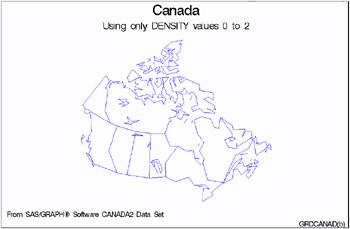Chapter 41: The GREDUCE Procedure
Overview
The GREDUCE procedure processes map data sets so that they can draw simpler maps with fewer boundary points. It creates an output map data set that contains all of the variables in the input map data set plus a new variable named DENSITY. For each observation in the input map data set, the procedure determines the significance of that point for maintaining a semblance of the original shape and gives the observation a corresponding DENSITY value.
You can then use the value of the DENSITY variable to create a subset of the original map data set. The observations in the subset can draw a map that retains the overall appearance of the original map but contains fewer points, requires considerably less storage space, and can be drawn much more quickly.
GREDUCE does not produce any graphics output. Instead, it produces an output map data set that can become either
-
the input map data set for the GMAP procedure
-
the input map data set for a DATA step that removes points from the map.
Figure 41.1 on page 1214 and Figure 41.2 on page 1214 illustrate the effect of reduction on a typical map data set. Figure 41.1 on page 1214 uses observations with all DENSITY values as input to the GMAP procedure.

Figure 41.1: CANADA2 Map before Reduction (GRDCANAD(a))

Figure 41.2: CANADA2 Map after Reduction (GRDCANAD(b))
Figure 41.2 on page 1214 uses only those observations with a DENSITY value of 0 or 2 as input to the GMAP procedure.
The program for these maps is in Example 1 on page 1220.
The reduced map shown in Figure 41.2 on page 1214 retains the overall shape of the original but requires only 463 observations compared to the 4302 observations that are needed to produce the map in Figure 41.1 on page 1214.
Note: Many of the map data sets that are supplied by SAS Institute already have been processed by GREDUCE. If the map data set contains a DENSITY variable, you do not need to process the data set using GREDUCE.
See also Chapter 42, The GREMOVE Procedure, on page 1223 for more information on how to
-
combine groups of unit areas into larger unit areas to create regional maps
-
remove some of the boundaries in a map and create a subset of a map that combines the original areas.